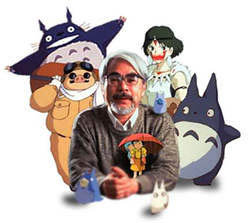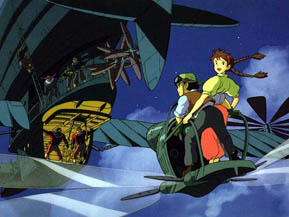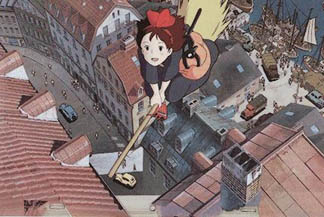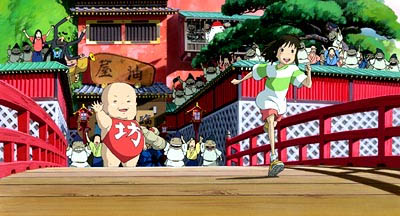
|
Drawn That WayBy Kim HollisApril 14, 2003
There’s currently a school of thought amongst movie and box office analysts that animated films may be losing steam as a viable medium. These folks will point to financial disappointments such as Treasure Planet, Atlantis and to a lesser degree, Spirit: Stallion of the Cimarron as examples of the downfall of traditional animation. Though it’s possible that recent outstanding computer-generated animation coming from Pixar, DreamWorks and Fox has made the more simple 2-D films from the major studios seem a bit more mundane, the outstanding box office performance of last year’s Lilo & Stitch along with last month’s Academy Award for the Japanese film Spirited Away both point to a resurgence in the quality and overall appeal of animated films as a whole. Another contributing factor to the alleged decline in popularity for animated films is the perception that “cartoons are for kids.” Though animated television series such as The Simpsons and South Park have definitely been able to find an adult niche, in the United States, that appeal simply doesn’t cross over to the world of cinema. Animated films specifically targeted toward older teenagers and adults have crashed spectacularly, with movies like Titan A.E. and Final Fantasy: The Spirits Within bringing down entire animation studios in the aftermath of their failures. Thanks to these troubles, it’s easy to make the sweeping generalization that older-targeted animation simply doesn’t have a market. Sadly, it’s this very narrow-mindedness that causes any number of wonderful films to be dismissed simply as “kiddie fare.” Though there’s little doubt that certain animated films (Piglet’s Big Movie, the Pokemon series) are really appropriate for youngsters only, that quality isn’t inherent to toons alone. As any studio will agree, overcoming the stigma attached to animation can be a tremendous challenge. To that end, each week I will highlight a different animated film in this column. I’ll examine old classics, upcoming features, foreign offerings, and new favorites. Since this column will be constantly evolving, I welcome feedback and suggestions. Just drop me a line at kim@boxofficeprophets.com. To get things started, I’m going to offer you three for the price of one. Tomorrow, three outstanding films will be released on DVD, all from Japanese director Hayao Miyazaki and Studio Ghibli. Often called the Japanese equivalent of Walt Disney, Miyazaki’s output over the past 20 years has been nothing short of exceptional, and his movies (with perhaps the exception of Porco Rosso) are appropriate for adults and children alike. Tomorrow’s releases, Castle in the Sky, Kiki’s Delivery Service and Spirited Away, span the spectrum of Miyazaki’s career, and offer a unique perspective on the director’s perception of Japanese and Western culture as well as being a reflection of his own ideals.
Castle in the Sky
Probably the most “adult” of today’s films, Castle in the Sky is at heart an adventure story with a conscience and is almost certainly the movie with the most purely evil character in Miyazaki’s repertoire. It has pirates and airships, environmentalism and morality, and heroes that are both enduring and empathetic. One of these primary characters, Sheeta, is a pretty young girl being held captive by the government. With her parents recently deceased, she is hardly able to fend for herself, but is still able to overcome her captors when the airship is attacked by pirates. Sheeta’s necklace is the object of the pirates’ affection, and as she is trying to escape, she falls off the side of the ship, and passes out. Fortunately, her necklace saves her life; it begins to glow and holds her up in the air, allowing her to gently and slowly glide down to the earth. As she falls to earth, she is caught by a young man who works in the local mine. His name is Pazu, and he has a true spirit of adventure. As the two get acquainted, she sees a photograph on the wall, and he tells her that his father took the picture of the fabled and mythical city of Laputa, a floating fortress in the sky, before his death. The two new friends don’t have long to discuss the story, though, because the pirates who attacked Sheeta at the beginning of the movie are back to try to capture her. Sheeta and Pazu make a daring escape, but are soon being chased not only by the pirates, but also by the government, it seems. What is the significance of the necklace and how is it related to the lost city of Laputa and Sheeta’s past? A number of eclectic themes are explored as the film progresses to its conclusion. One recurring topic that Miyazaki tends to return to again and again is the importance of the environment and the proper use of technology. Castle in the Sky is a fairly black and white analysis of these ideas, which is somewhat unusual for the director/writer. Though the pirates are typical Miyazaki villains in that they are trouble-making rogues who still manage to be endearing, there is a truly evil character with absolutely no redeeming qualities - he is a man who wishes to use technology for his own depraved goals. In stark opposition is the selfless sacrifice of Sheeta and Pazu, who recognize special beauty for what it is and make a conscientious attempt to preserve serenity of nature. It’s also nearly impossible to discuss Castle in the Sky without making special note of the airplanes, gliders and airships along with the gorgeous scenes of flight that occur throughout the movie. The various aircraft have been created with extremely loving and attentive detail. It should come as no surprise that Miyazaki is an ardent fan of French writer/aviator Antoine de Saint-Exupery, who used his own experiences as a pilot to craft memorable tales such as Night Flight and Flight to Arras. The visions of flight in Castle in the Sky are a lovely precursor to Miyazaki’s later masterpiece, Porco Rosso, which has flight scenes that are grounded more in reality but are still breathtaking in their exquisite beauty and perfection. Also very worthy of mention is the delicious score by Joe Hisaichi, who composes the music for the majority of the output from Studio Ghibli. The soundtrack that accompanies the film is exceptionally memorable and matches the action and moods perfectly. Though his scores are always a delight, this one easily stands out as one of the three best. Special features on this two-disc set include an introduction from (founder and creative frontman for Pixar Animation), a voice talent featurette, the original Japanese trailers, and storyboards. I have never seen the English-language dub of this particular film, but the voice talent is fine, including such well-known names as Anna Paquin (as long as she doesn’t use a Southern accent, anyway) and James Van Der Beek. For purists, the film can also be viewed with its Japanese track along with English subtitles. A French-language track is available as well.
Kiki's Delivery Service
Based on a book by Eiko Kadono, Kiki’s Delivery Service is beloved among fans of both anime and Studio Ghibli in particular. Unlike the conflict-laden and more action-oriented Castle in the Sky, Kiki’s Delivery Service has a minimum of conflict but is instead a coming-of-age, episodic character study about a teenage girl who learns self-reliance. This film has no villains - though there are a couple of characters who aren’t really very nice - and the pace is more deliberate so as to give a real slice-of-life look at a delightful character and the city that surrounds her. Kiki is a young witch who has just turned 13 years of age, which means that it is time for her to set off on her own and find her own city to set up business. She’s excited and enthusiastic as she departs to discover her new place, with her cat Jiji by her side. Kiki and Jiji have grown up together and are so close that they speak the same language. The young witch has no discernible skills other than the fact that she can fly on a broomstick, but she has no end of vivacity as she searches for her new home. After awhile Kiki spots a beach town that looks absolutely dreamy to her. She lands, and though she has a spot of trouble to start, she soon finds that her niche just might be delivering items for customers in need of speedy shipment. The kindly and pregnant Osono offers to let Kiki run her business out of the bakery and also gives her room and board for free in exchange for Kiki doing some fill-in work in the shop. As Kiki learns her trade, she goes through the typical growing pains for a girl her age. A boy named Tombo seems to like her, but she distrusts his intentions and resists his attempts at becoming friends. She looks at her reflection in a shop window and frets about her appearance, and is especially self-conscious about her black dress, the “uniform” of the witch. Ultimately, she winds up having a crisis of faith of sorts, causing her to lose some of her abilities and question her own dedication to her chosen career path. It’s truly impossible to watch this film without falling head over heels in love with both Kiki and Jiji. Her purity of heart is genuine and heartfelt, but is amusingly counterbalanced with Jiji’s wry and sarcastic personality. Along with the delightful characters, Miyazaki has created an absolutely spectacular seaside town, with vibrant colors and luscious designs based on cities such as Paris, Stockholm, Naples, Amsterdam, Lisbon and San Francisco. If you’ve ever been to Europe, the spectacular scenery will make you yearn to go back. Add Joe Hisaichi’s superb score to the mix and the sense of the Western European seaside is elevated to a sublime level. Kiki’s Delivery Service definitely follows a Japanese anime tradition of creating films that specifically appeal to and feature teenage girls; however, it is so earnest and heartfelt that it is one of Miyazaki’s most universal offerings, with something for people of all ages. The film has been released previously in the U.S., but this DVD release is superior to anything previously offered by far. Though some viewers have been unhappy with the changes made from the subtitled version to the dub, Phil Hartman fans will still be delighted to know that he provides the voice of Jiji the cat, and that his performance is widely recognized as outstanding. Kirsten Dunst, Janeane Garofalo and Tress MacNeille also do voice work in the English language dub, with Dunst in the title role. Features included on this new DVD release are basically identical to the ones on the Castle in the Sky disc. Though Kiki’s Delivery Service is by no means as weighty a film as other Miyazaki offerings, it is a beautiful, consistently upbeat and enjoyable work. It’s also very worthy of repeat viewings, and is especially good for alleviating the rainy-day blues.
Spirited Away
An absolute visual spectacle, Spirited Away is a recent Academy Award winner and one of the highest overseas-grossing films in history. It recently returned to theaters after its Oscar win, where it performed somewhat modestly, though certainly better than it did on its first domestic run. Now, the film is available in a terrific DVD package from Disney, and the hope is that a wider audience will now be able to fall in love with Miyazaki’s work thanks to the visibility and recognition Spirited Away has received. Though he had initially announced his retirement after the completion of Princess Mononoke, Miyazaki soon decided that he wanted to make a film that was specifically targeted toward what he felt was an underserved demographic in Japan – pre-teen girls. He personally knew some pre-adolescent girls that he saw as apathetic and full of ennui, and he based the lead character in Spirited Away on his young friends with the goal of making a movie that he knew they would appreciate and enjoy. What resulted was a feast for both the eyes and the heart, and the film went on to become the highest-grossing in Japanese history, winning copious numbers of awards on its journey toward its Disney-supported release in the U.S. The centerpiece of the story, of course, is Chihiro, a ten-year-old girl who is pouting and sullen as her family moves to a new home. She’s in a position where she’ll have to make all new friends, and the prospect clearly intimidates her greatly. As she rides in the car with her parents to their new house, they find themselves lost in front of a strange tunnel. The family gets out to investigate, and discovers a weird town that Chihiro’s father believes is the remnants of an amusement park. Either way, there is some delicious food at an otherwise deserted restaurant, and Chihiro’s parents settle in for a delicious meal. For some reason, Chihiro refuses to eat. Suddenly, her parents have literally turned into pigs, with no capability of communicating with their daughter. Chihiro runs away, and soon notices that she is fading away, a mere shadow of herself. A boy approaches and offers his help by giving her sustenance that allows her to return to her body. He tells her that she will need to try to get a job at the local bath house, which is run by the rather unpleasant Yubaba. Chihiro gets her job, but it costs the youngster her name. Yubaba confiscates the name and dubs her new employee with the moniker of Sen. As long as Yubaba has Chihiro/Sen’s name, she will be unable to return to the “real world,” as she has quickly discovered that she and her family have somehow been transported to the world of the spirits. The bath house is a respite for those spirit beings. That’s really just a small tidbit of what happens in the very first portion of the movie, and it definitely gets stranger and more delightful from there. With shades of The Wizard of Oz and Through the Looking Glass, we are transported with Chihiro to this odd spirit world. The creatures are wildly varying in personality; she encounters kindly friends, a self-centered villain (of sorts), and a weird, ambiguous being called No-Face that shifts from friendly and generous to angry and destructive before returning to become a gentle soul. Though Spirited Away is most certainly a film that should be seen on the big screen (and to Miyazaki’s mind, the only way to see his films are in movie theaters), it also happens to be a movie that should benefit from its domestic DVD release because it is much, much better with repeat viewings. The first time seeing the film, the visuals are almost a little overwhelming, so it is difficult to take everything in, including the story. With additional viewings, small nuances in the story become clearer, with multiple interpretations possible for different elements and themes that occur throughout the film. Spirited Away is as deep and layered as any film you’re likely to see, yet it is also completely accessible to children and adults alike. The DVD includes both the Japanese-language track (with English subtitles) and the English dub, so it is possible to see the movie in both its original format and with the Miyazaki-approved English-language voices and screenplay. Major voices in the John Lassiter-headed English-language version include Daveigh Chase (who was also the voice of Lilo in last year’s Lilo & Stitch), David Odgen Stiers, Suzanne Pleshette, and John Ratzenberger. Though there is a significant amount of debate about whether it is preferable to watch the film in its subtitled format or with the dub (some of the lines added to the dub have been slightly controversial), I contend that the dub is very well-done and that the movie should be watched both ways, particularly because watching the dub allows greater appreciation of the amazing imagery without the distraction of having to “read the story.” It’s really all a matter of preference, though. Features included on the new two-disc set include an introduction from John Lasseter, a featurette about the voice work in the film, a feature titled “The Art of Spirited Away,” selected storyboard to film comparisons (with the capability of switching back and forth while the movie is playing), and the original Japanese trailers. The film is a terrific way to cap off the Miyazaki movie experience, and will hopefully encourage viewers to become more interested in some of his other films, not to mention broadening their horizons to the possibilities inherent in the animation medium. |
Thursday, January 01, 2026
© 2006 Box Office Prophets, a division of One Of Us, Inc.